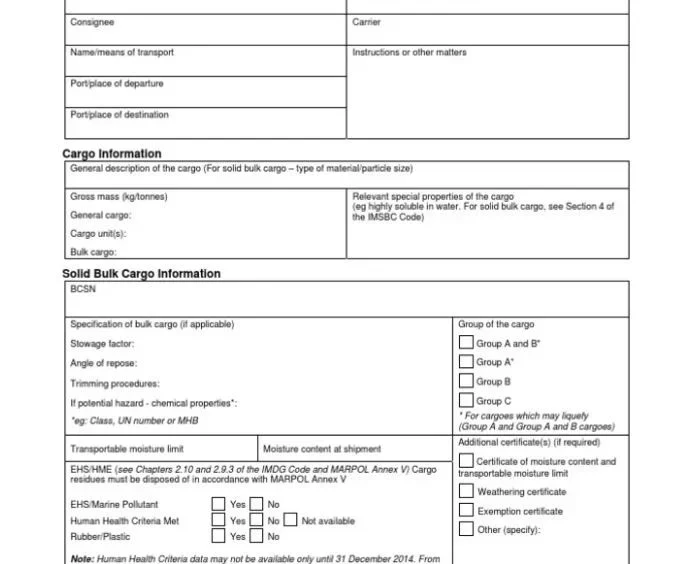When loading bulk cargo, especially solid bulk cargo like coal, iron ore, bauxite, or even grain, one of the most important documents you must be aware of is the Shipper’s Declaration. This is not just a routine paper. It is directly linked to cargo safety, ship stability, and crew safety.
As a cadet or junior officer, you may not be handling documents yourself, but understanding what this declaration means will help you become a more competent officer in future.
What is a Shipper’s Declaration?
A Shipper’s Declaration for bulk cargo is a legal document that is submitted by the shipper to the vessel’s Master or agent, providing accurate information about the cargo to be loaded.
It is a requirement under the IMSBC Code (International Maritime Solid Bulk Cargoes Code) – which governs the safe loading, carriage, and discharge of solid bulk cargoes.
This declaration must be submitted in writing well in advance of loading.
Why is it so Important?
Incorrect cargo information has led to many marine accidents, including capsizing, fire, and loss of life. For example, if a cargo is wrongly declared as “safe” when it actually has a high moisture content, it can liquefy during the voyage, making the ship unstable.
That’s why the Master must receive accurate and complete cargo information – and this declaration ensures that.
What Information Is Included in the Shipper’s Declaration?
The contents may vary depending on the cargo, but in general, the declaration must include:
Proper shipping name of the cargo (as per IMSBC Code)
IMO class or UN number, if applicable
Cargo Group (Group A – prone to liquefaction, Group B – chemical hazards, Group C – no known hazards)
Bulk density, angle of repose, and stowage factor
Moisture content of the cargo (for Group A)
TML (Transportable Moisture Limit)
Flow moisture point (if required.
Oxygen depletion risk or self-heating properties, if any
Whether the cargo can emit toxic or flammable gases
Whether any ventilation is required
Any special precautions, PPE, or segregation required
Date, name, and signature of the shipper or responsible party
What Should You Watch Out for as a Deck Cadet or Junior Officer?
Even if you’re not the one signing or verifying documents, during cargo operations you must pay attention to:
- Group of the Cargo
If it’s Group A, be alert – this means risk of liquefaction. During loading, you might see signs like cargo appearing shiny, wet, or free-flowing. Report immediately.
- Moisture Content and TML
If moisture content is above TML, the Master must refuse to load. Ask your Chief Officer to explain the values on real cargo documents.
- Cargo Sampling and Testing
Sometimes cargo samples are provided onboard. You may be asked to witness sampling or check lab reports. Observe and learn.
- Special Hazards
Some cargoes like DRI (Direct Reduced Iron) or coal can emit flammable gases, or self-heat. Cadets must check warning notices posted near cargo holds and on the declaration.
- Ventilation Instructions
Some cargoes need surface ventilation or even mechanical ventilation. Keep watch and follow the instructions as per declaration.
What Can Go Wrong if the Declaration is Inaccurate?
Ship may lose stability mid-voyage
Fire or toxic gas buildup in cargo holds
Overloading due to incorrect density or stowage factor
Wrong hold preparation (leading to contamination or damage)
Violation of IMSBC Code, PSC detention, and heavy fines
In worst cases – loss of ship and lives
Where Is the Shipper’s Declaration Kept?
The Chief Officer or Master usually files it with the cargo documents, and a copy is kept onboard for inspection. During audits, vetting, or PSC, the declaration must be produced if requested.
Final Thoughts
The Shipper’s Declaration is not just paperwork – it’s your ship’s first line of defence against cargo-related disasters. As a cadet or junior officer, this is the right time to start developing a habit of checking what cargo is coming onboard, asking questions about its properties, and cross-checking real documents.
The more curious and aware you are during cargo operations, the more confident and competent you will become as an officer in the coming years.
Understanding the cargo is not just the job of the Chief Mate, it starts with the cadet.


